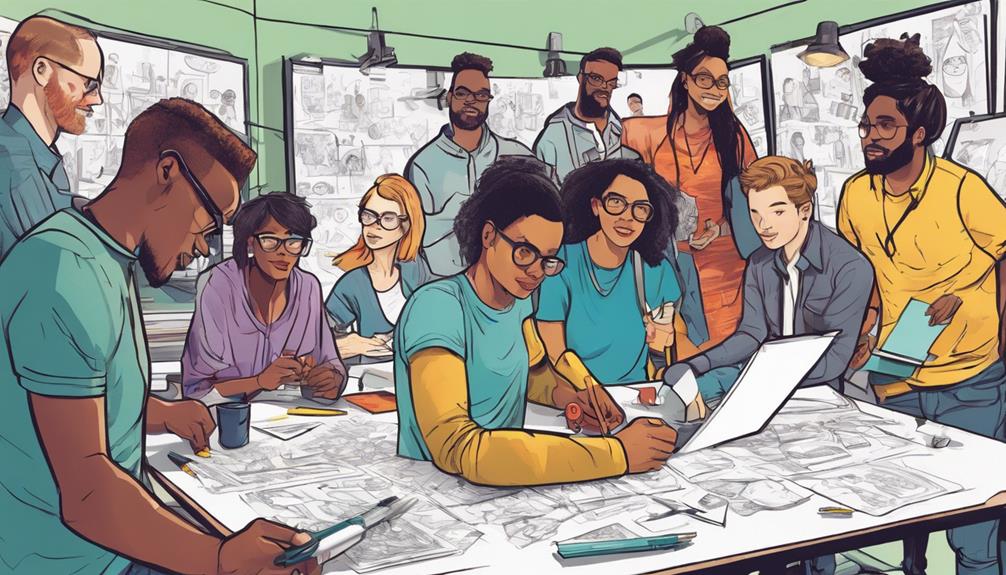In the design thinking process, you should reflect on past stages for improvement. Generate diverse prototype ideas to discover breakthroughs. Gather customer feedback to refine solutions and stay user-centered. Address emerging problems promptly and adapt strategies flexibly. Focus on continuous improvement to guarantee innovative, effective designs that meet user needs. These steps guide you towards creating impactful solutions that evolve with feedback and challenges, enhancing your design process and outcome.
Key Takeaways
- Embrace diverse prototype ideas for breakthroughs.
- Gather customer feedback for refinement.
- Address emerging problems promptly.
- Stay focused on continuous improvement.
- Adapt strategies based on feedback and challenges.
Reflect on Previous Stages
To improve project outcomes, make sure you regularly revisit and reflect on the progress made in previous stages of the design thinking process. Reflecting on previous stages allows you to identify areas for improvement in your solutions. By evaluating the effectiveness of your past work, you can confirm that your design is aligned with user needs and project goals. This reflection also promotes continuous learning within your team and encourages adaptation to changing circumstances.
Reflecting on past work provides valuable insights into what worked well and what could be improved. It gives you the opportunity to learn from both successes and failures, ultimately leading to a more refined and user-centric design.
Generate Diverse Prototype Ideas

Regularly revisiting and reflecting on the progress made in previous stages of the design thinking process can pave the way for generating diverse prototype ideas. To ensure your design team explores a wide range of solutions and fosters innovation and creativity, take into account the following:
- Create Less Viable Prototypes: Don't shy away from unconventional ideas; they may lead to unexpected breakthroughs.
- Uncover Unique Approaches: Diverse prototypes can help in revealing novel ways to address problems and meet user needs.
- Experiment and Iterate: Embrace experimentation to conduct a thorough exploration of potential solutions.
- Consider Different Perspectives: Generating a multitude of prototype ideas enables the team to ponder various viewpoints.
- Iterate Towards Best Solutions: Through the process of generating diverse prototype ideas, the team can iterate towards finding the most effective and innovative solutions.
Gather Customer Feedback

Incorporate customer feedback by creating surveys to gather insights from potential users.
Actively seek feedback on prototype ideas to refine and improve them. This iterative process allows for the identification of any problems that may arise and enables the design team to make necessary adjustments.
By gathering feedback from customers, you can guarantee that your solutions are truly user-centered and meet their needs effectively. Continuous improvement is key, so take the feedback received and use it as a basis for reflection and refinement.
This feedback loop not only helps in refining the current design but also informs future iterations. Remember, the goal is to create a product that resonates with your users, and by integrating their feedback, you can achieve a more successful outcome.
Stay focused on refining your ideas based on the feedback received to maintain a user-centered design approach throughout the process.
Address Emerging Problems

When confronted with unexpected challenges during the design thinking process, design teams must be ready to swiftly address and overcome these emerging problems. It's pivotal to stay adaptable and pivot as needed to continue making progress.
Being flexible and open to refining ideas based on these emerging challenges is key to achieving successful outcomes. Continuous problem-solving and adjustment are essential components of an iterative design process, ensuring that the final product meets user needs effectively.
Embracing change and seeking innovative solutions to emerging problems can lead to more efficient and impactful designs.
- Flexibility: Stay open to changing course when necessary.
- Problem-Solving: Actively address and solve unexpected issues.
- Adaptation: Be willing to adjust strategies and approaches.
- Innovative Solutions: Explore creative ways to overcome emerging challenges.
- Refining Ideas: Continuously improve and iterate on design concepts based on feedback and new insights.
Focus on Continuous Improvement

To enhance the quality of your design solutions, prioritize focusing on continuous improvement throughout the design thinking process. Continuous improvement involves reflecting on previous stages, promoting innovation through a variety of prototype ideas, and ensuring user-centered design.
Gathering feedback through surveys from potential customers is vital for refining prototypes and addressing emerging problems effectively. It's essential to adapt and improve your design solutions as new challenges arise during the process.
Frequently Asked Questions
What Might the Design Team Need to Do During the Design Process?
During the design process, you need to stay open to new ideas, gather feedback from users, and adapt to address emerging issues. Keep iterating, reflecting on past work, and promoting user-centered design for success.
What Is Involved in the Process of Design Thinking?
In the process of design thinking, you engage in stages like Empathize, Define, Ideate, Prototype, and Test. It's a journey of creativity and problem-solving, where innovation flourishes through collaboration and user-centric design principles.
What Are Some of the Characteristics a Design Thinking Team Should Process?
To excel in design thinking, your team should embody empathy, creativity, collaboration, adaptability, and effective communication. Challenge assumptions, seek feedback, and embrace continuous improvement. Understanding user needs and working cohesively are crucial for innovative solutions.
What Do You Need for Design Thinking?
You need creativity, empathy, and feedback for design thinking. Generating ideas, understanding users, and refining designs with feedback are essential. Stay adaptable, solve new problems, and focus on continuous improvement for successful user-centered design.
Conclusion
As you move forward in the design thinking process, remember to stay open to feedback and new ideas.
By reflecting on previous stages, generating diverse prototype ideas, and addressing emerging problems, you can create innovative solutions that truly meet your customers' needs.
Keep pushing yourself to improve and never settle for the status quo.
Your dedication to continuous improvement will lead to successful outcomes and drive positive change in your design projects.









